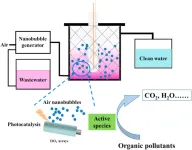(Press-News.org) URBANA, Ill. — From self-driving tractors to weeding robots and AI-powered data collection, automated machinery is revolutionizing agricultural production. While these technological advancements can greatly improve productivity, they also raise new questions about safety measures and regulations. To address these issues, a recent study from the University of Illinois reviewed current academic literature on the safety of automated agricultural machines. Based on a review of more than 60 papers, the researchers identified three main topics: environmental perception, risk assessment and mitigation, and human factors and ergonomics.
“The majority of the research focuses on the first category, environmental perception. These studies primarily deal with how machines sense obstacles in the environment and respond to them. There is limited work on risk assessment or ergonomics,” said Salah Issa, Illinois Extension specialist and assistant professor in the Department of Agricultural and Biological Engineering (ABE), part of the College of Agricultural, Consumer and Environmental Sciences and The Grainger College of Engineering at the U of I. Issa is corresponding author on the paper.
Automated machines detect objects through perception sensors, which are then interpreted through machine learning algorithms to direct the equipment to stop, slow down, or change direction. There are three main types of obstacles that machines must be able to handle: positive, negative, and moving. Positive obstacles are objects that appear above ground, such as rocks, trees, and buildings. Negative obstacles are those that are lower than ground level, such as ditches and holes. Moving or dynamic obstacles are those that appear suddenly, such as a human being, an animal, or other moving machinery. These obstacles can vary widely, depending on type of crop, features of the area, and weather conditions.
Issa and co-author Guy Roger Aby, doctoral student in ABE, found the research papers explored a wide variety of different receptor and sensor types, including 3D laser scanners, ultrasonic sensors, remote sensing, stereo vision, thermal cameras, high-resolution cameras, and more. Each type has advantages and limitations, and the most effective approaches include a combination of different methods.
“The trend in literature is towards utilizing multiple types of sensors, as opposed to just a single sensor. This is also the direction most companies are taking. It makes perfect sense for agricultural machines, given the very dynamic environments they operate in,” Issa noted.
“However, there are still many questions that need to be addressed. For example, sensors must be sensitive enough to stop immediately if a human or other object appears. But if the machine stops and the farmer is not present, would they need to go back to check on the sensor and reset the machine? This is particularly challenging when it comes to quickly moving obstacles, like a passing squirrel or bird.”
Automatic agricultural vehicles face some of the same challenges as self-driving cars, but there are also notable differences. For instance, agriculture presents a more complex environment than city driving, where roads are structured and marked. However, erratic human behavior in other drivers is a concern on city roads, but is less of a factor in agricultural fields, Issa notes.
Only a few research papers addressed the second topic, risk assessment techniques and strategies. Issa says this is not surprising because most systems used in engineering for risk evaluation rely on historical data. That does not yet exist for autonomous systems in agriculture; there is little publicly available data about how they work and what the inherent risks are.
“We believe that existing safety standards are not well-suited for autonomous systems. But there’s a significant effort underway to revise the current standards, so in a few years there will be new and revised standards,” he said. Safety regulations addressing injuries and fatalities fall under the federal Occupational Safety and Health Administration (OSHA) but some states, including California and Indiana, also have their own regulations.
The researchers identified a limited number of papers on the third topic, human factors and ergonomics.
“This is a particularly challenging issue in agriculture. In most manufacturing industries, human-robot interaction can be minimized. But some agricultural robots, such as harvesters and pickers, are designed to work in the same space as humans. The few papers on this topic explored human-robot interactions from an ergonomic perspective, focusing on how to improve machine design to ensure safety,” Issa said.
While autonomic robots are an emerging technology, some machines are already commercially available. For example, one company manufactures automatic sprayers for orchards, and self-driving tractors are being tested and implemented in select areas. Automated agricultural machines will undoubtedly become indispensable parts of modern farming in the next few decades, and robust safety systems are crucial for their widespread adoption, Issa and Aby concluded.
Issa directs the UIUC Agricultural Safety and Health Program, which has launched a series of ag safety initiatives, including a Linkedin group and a special issue of the Journal of Agricultural Safety and Health. Issa is also an affiliate in the Center for Digital Agriculture and the National Center for Supercomputing Applications.
Editor’s Notes:
The paper, “Safety of Automated Agricultural Machineries: A Systematic Literature Review,” is published in MDPI Safety [DOI: 10.3390/safety9010013]. Authors include Salah Issa and Guy Aby.
The College of Agricultural, Consumer and Environmental Sciences (ACES) at the University of Illinois has top-ranked programs, dedicated students, and world-renowned faculty and alumni who are developing solutions to the world’s most critical challenges to provide abundant food and energy, a healthy environment, and successful families and communities.
END
Automated agricultural machinery requires new approaches to ensuring safety
2023-05-16
ELSE PRESS RELEASES FROM THIS DATE:
Experts say it’s not yet time to take off masks in the health care setting
2023-05-16
1. Experts say it’s not yet time to take off masks in the health care setting
Abstract: https://www.acpjournals.org/doi/10.7326/M23-1190
URL goes live when the embargo lifts
A new commentary from infectious disease experts at George Washington University School of Medicine and the National Institutes of Health (NIH) says for patient safety, masking should continue in health care settings. This message conflicts with a recent commentary from authors from 8 U.S. institutions suggesting that the time for universal masking is over. The commentary is published in Annals of Internal Medicine.
Masking has been a controversial ...
The number of the world's farms to halve by 2100, study shows
2023-05-16
New University of Colorado Boulder research shows the number of farms globally will shrink in half as the size of the average existing farms doubles by the end of the 21st century, posing significant risks to the world’s food systems.
Published today in the journal Nature Sustainability, the study is the first to track the number and size of farms year-over-year, from the 1960s and projecting through 2100.
The study shows that even rural, farm-dependent communities in Africa and Asia will experience a drop in the number of operating farms.
“We see a turning point from widespread farm creation to widespread consolidation on a global level, and that's ...
Investigation raises questions over lack of “substantial evidence” for FDA approved antibiotic
2023-05-16
Drugs approved in the US require “substantial evidence” that they are effective. But an investigation by The BMJ into the recent approval of the antibiotic Recarbrio from Merck suggests that these standards are being bypassed.
Peter Doshi, senior editor at The BMJ, describes how US Food and Drug Administration (FDA) scientists had serious doubts about Recarbrio - a product 40 times more expensive than an existing generic alternative - but the agency approved it anyway.
Did the FDA break its own rules in approving this antibiotic, and what does this case tell us about problems within the agency, he asks?
Recarbrio is a combination therapy made up ...
Chemical exposure may raise your risk for Parkinson’s
2023-05-16
Two years of heavy exposure to TCE, a liquid chemical that lingers in the air, water and soil, may increase the risk of Parkinson’s disease by 70%.
Previous research has linked TCE, or trichloroethylene, to certain cancers, but a new study publishing in JAMA Neurology on May 15, 2023, is believed to be the first large-scale study to demonstrate its association with Parkinson’s.
TCE has been used for industrial and commercial purposes for nearly 100 years, and was used ...
How old are your bones?
2023-05-16
Researchers from The University of Technology Sydney (UTS) have measured the extent to which a bone fracture can lead to early death, and created a publicly available tool that doctors and patients can use to calculate risk.
The research, ‘Skeletal Age’ for mapping the impact of fracture on mortality has just been published in the prestigious scientific journal, eLife.
In the study of more than 1.6 million adults, the scientists found that a bone fracture was associated with a loss of one to ...
IU researchers find link between obesity and blood cancer
2023-05-16
Indiana University School of Medicine researchers studying clonal hematopoiesis of indeterminate potential (CHIP), a blood condition that may increase the risk of blood cancer, discovered that obesity was strongly associated with the condition. Their findings were recently published in the Journal of Clinical Investigation.
CHIP is a condition where blood cells accumulate genetic mutations, increasing the risk of developing blood cancer. Although CHIP is common in aging, the risk factors that contribute to the condition are poorly understood.
“Our study’s results showed being overweight ...
Degradation of Rhodamine B in the photocatalytic reactor containing TiO2 nanotube arrays coupled with nanobubbles
2023-05-16
The study is led by Xiaojun Han (School of Chemistry and Chemical Engineering, Harbin Institute of Technology).
With the rapid development of urbanization and industrialization, environmental problems became increasingly serious. Dye wastewater is considered to be one of the biggest challenges due to its high toxicity. Organic dyes have mutagenic, teratogenic, and carcinogenic properties, and threaten the health and life of humans while hindering plant photosynthesis, which brings risks to the ecosystem. Traditional organic pollutant treatment ...
Occasional cannabis use during pregnancy may be enough to impact fetal growth significantly
2023-05-16
As more people use cannabis for recreational purposes, attitudes towards the drug have changed. For example, research has shown that dispensaries often recommend cannabis – also referred to as marijuana – to pregnant women to ease pregnancy symptoms, especially morning sickness.
There is a growing body of literature attesting to poor child outcomes if cannabinoids are consumed during pregnancy. The exact effects on the developing fetus, however, remain unclear. Researchers in the US have now examined how timing of cannabis exposure during pregnancy impacts fetal development.
“We show that even when marijuana use occurred only ...
Severe hot flashes after menopause increase metabolic syndrome risk in women
2023-05-16
EMBARGOED UNTIL SUNDAY 14 MAY 2023 AT 00:01 CET
Severe hot flashes after menopause increase metabolic syndrome risk in women
Women who experience more severe hot flashes after menopause are more likely to develop metabolic syndrome and high blood pressure, according to research presented at the 25th European Congress of Endocrinology in Istanbul. The findings of this long-term study highlight the importance of using hormone replacement therapy for menopause in these women.
Metabolic syndrome is a group of three or more ...
Newly discovered RNA molecules hold promise for detecting and treating esophageal cancer
2023-05-15
CLEVELAND—Irregularities in the body’s genetic coding to make proteins are linked to cancerous tumors. But most genetic material contains elements whose function isn’t clear.
Could abnormalities in non-coding material also impact a person’s health, or even be linked to cancers as well?
A new study by researchers at the Case Western Reserve University School of Medicine suggests that the non-coding genetic molecules also play a key role in health and disease, including tumor development.
More specifically, ...


